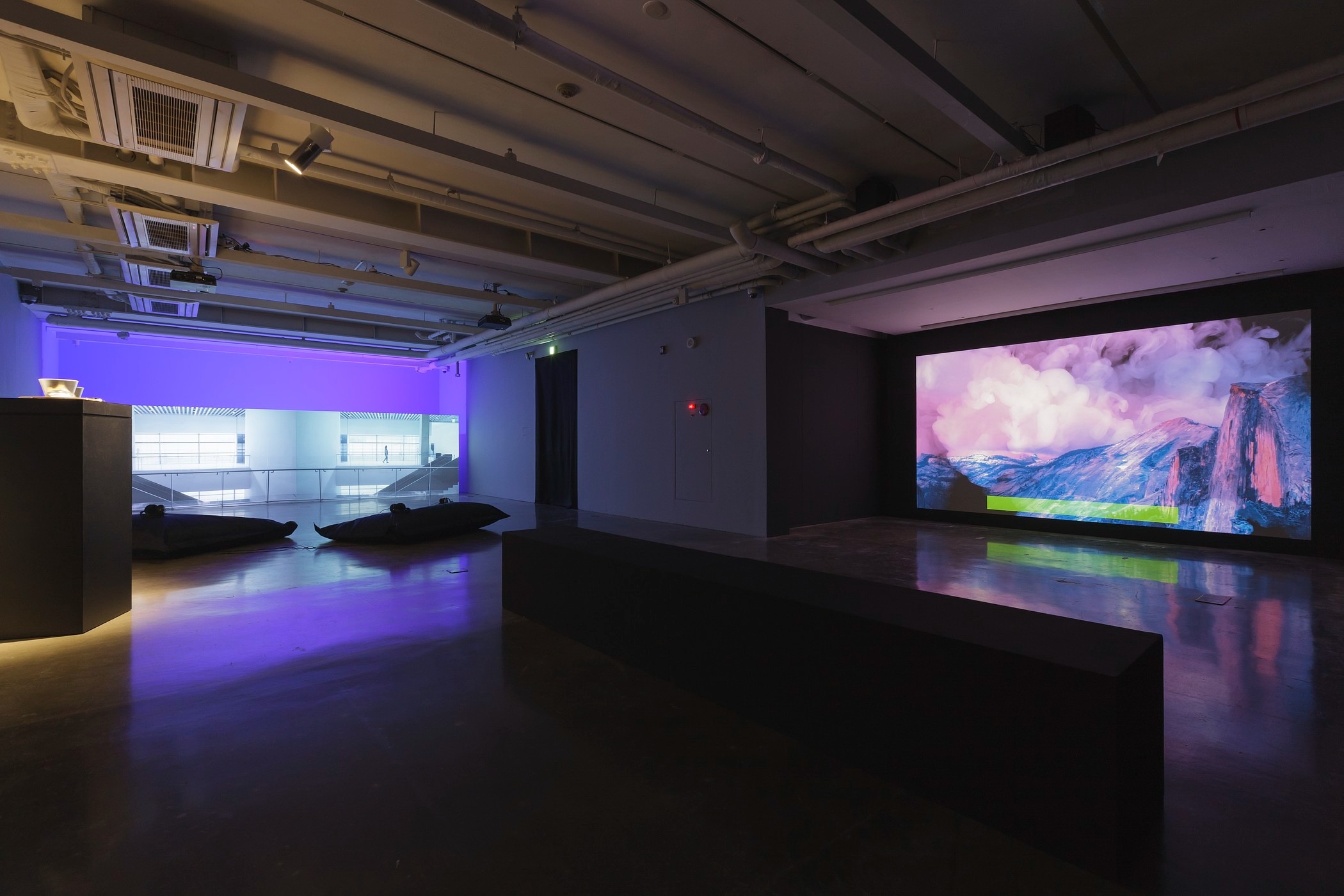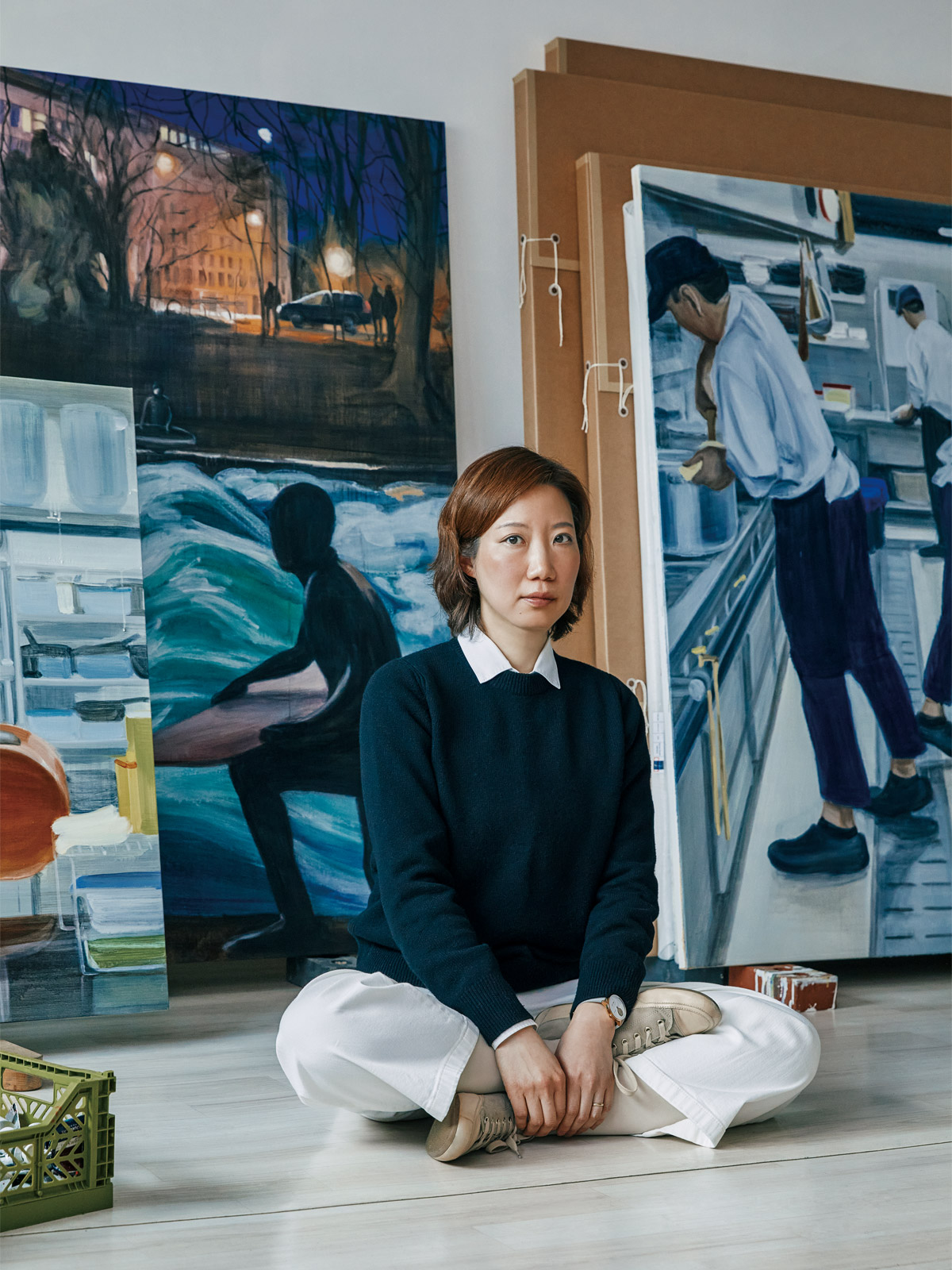Sejin Kim (b. 1971) explores the lives of
individuals within the complex, multifaceted structures of contemporary society
through film techniques that blend cinema and documentary, as well as through
sound and video installations, creating a multisensory experience.
The artist focuses on the alienation,
isolation, anxiety, and loneliness that inevitably arise as “anonymous
individuals” within systems resist or adapt to societal regulations. Recently,
Kim has delved into the diverse networks emerging within digital environments,
continuing to reveal the uncertain and fluid structures of today’s world.
 Sejin Kim, Take
a Picture, 2002 ©Gyeonggi Museum of Modern Art
Sejin Kim, Take
a Picture, 2002 ©Gyeonggi Museum of Modern ArtIn
Take a Picture (2002), exhibited in Project 3 of the Gwangju
Biennale, Sejin Kim focuses on the historical specificity of Gwangju, using the
medium of video to reflect on the history of individuals and collectives.
Through the question, “Is history truly absolute?” Kim captures students posing
for a commemorative photo in a three-minute video.
The
students, initially appearing frozen in place for a photograph, suddenly start
moving, revealing the piece as a video rather than a static image. Through
this, Kim suggests that history, unlike a photograph confined within a single
frame, is a mutable concept that can be reinterpreted and rewritten over time,
using the inherent properties of video to convey this idea.

Sejin Kim, Night Watch, 2006 ©ARKO
In Night Watch
(2006), a three-channel video work created during the artist’s stay in Taipei,
Sejin Kim captures the lives of individuals in Asian countries. Within a city
where the lights stay on even through the night, the artist observes the shared
lifestyle patterns of modern people living in Taiwan, Korea, and other Asian
countries, along with the various symptoms that emerge from this way of life.
Unlike Western cities, Asian cities
operate around the clock under the glow of neon signs, presenting a vibrant but
complex landscape where loneliness and alienation coexist beneath the surface.
Kim portrays these subtle yet pervasive feelings of isolation and solitude
experienced by city dwellers.
The three channels of Night
Watch depict people eating alone, a blind person playing the
harmonica on the street, and the city’s dazzling yet melancholic neon-lit
nightscape. Through these scenes, the artist reveals the invisible gap between
the constantly transforming urban spaces and the identity of modern life within
them.
 Sejin
Kim, Sleeping
Sun, 2012
©Sejin Kim
Sejin
Kim, Sleeping
Sun, 2012
©Sejin KimSince
the 2010s, Sejin Kim’s work has focused on themes of life and labor as an
outsider, influenced by her experiences in international residencies and
studying in the UK. Sleeping Sun (2012), based on her time
in England, revisits memories of unjust experiences as a foreigner through a
fictionalized and imagined space-time.
Unlike
previous works, Sleeping Sun directly incorporates a
narrative style. Here, the real setting of England in 2012 transforms into an
unnamed planet, and the artist portrays herself as an alien with half-blonde,
half-black hair—an Asian woman.

Sejin Kim, Sleeping Sun, 2012 ©Sejin Kim
In
Sleeping Sun, the alien who has arrived on an unnamed planet
in search of a better future looks around her surroundings before meeting the
viewer’s gaze, her eyes reflecting a cityscape. She then appears standing like
a giant among small houses, while a control tower in the city emits continuous
sounds, seemingly giving her instructions.
Although
the city of England is depicted in a distorted form, Kim’s experience of being
othered is transformed into a sense of agency through the protagonist, the
alien. This character reclaims her narrative, turning the experience of
alienation into an empowered, self-possessed image.
 Sejin Kim, Proximity
of Longing, 2016 ©Sejin Kim
Sejin Kim, Proximity
of Longing, 2016 ©Sejin KimThis narrative intervention evolves in
Proximity of Longing
(2016), a video work presented at the SONGEUN Art Award exhibition,
where it takes the form of a “visual narrative.” According to the artist,
visual narrative does not build structure through traditional storytelling
elements, as in literature or film. Instead, it constructs a multisensory
narrative structure through components like visuals, sound, and framing.
Proximity of Longing employs various
methods of moving images, such as found footage, live-action filming, and
animation, along with the addition of voice-over and subtitles, attempting
documentary grammar and techniques as a new form.
 Sejin Kim, Proximity
of Longing, 2016, Installation view of “16th
SONGEUN Art Award” (SONGEUN, 2016-2017) ©SONGEUN
Sejin Kim, Proximity
of Longing, 2016, Installation view of “16th
SONGEUN Art Award” (SONGEUN, 2016-2017) ©SONGEUNProximity of Longing is
based on this new multisensory visual narrative structure and consists of three
episodes: Twelve Chairs, Angel Island,
and Tortilla Chinantla. The work addresses global migration
and immigration phenomena, as well as the personal histories, historical
foundations, and collective utopias underlying these movements.
The first episode, Twelve
Chairs, focuses on abandoned chairs found on Ellis Island in the
eastern United States, where European immigrants once awaited entry screenings.
It examines the lasting influence of the power wielded by dominant nations
throughout history.
Angel Island, the second
episode, juxtaposes poems left by Asian immigrants in the U.S. with the history
of discrimination they faced as minorities. The final episode,
Tortilla Chinantla, explores the history of Mexican
immigration in the U.S. through one of America’s most popular foods, the
tortilla, highlighting the desire for a collective utopia and the gap between
this aspiration and reality.
 Sejin Kim, Messenger(s),
2019 ©SONGEUN
Sejin Kim, Messenger(s),
2019 ©SONGEUNIn
2019, after winning the Grand Prize at the 16th SONGEUN Art Award, the artist
held a solo exhibition titled “Walk in the Sun” at SONGEUN. The exhibition
featured new works based on the artist’s journey from Antarctica to the Arctic
region of Lapland. These new pieces highlight the gap between reality and
illusion by either depicting real stories through fictional images or fitting
real stories and images into fictional narrative structures.
One
of these works, Messenger(s) (2019), is a hyper-realistic
video piece featuring ‘Laika,’ the "space dog" who became the first
living creature to orbit Earth aboard the Soviet satellite Sputnik 2. Through
3D motion graphics, the artist recreates Laika, symbolizing a messenger, to
reflect humanity's desire for exploration and expansion into the unknown, while
also commemorating the countless beings sacrificed in the name of progress.
 Sejin Kim, 2048,
2019 ©Sejin Kim
Sejin Kim, 2048,
2019 ©Sejin Kim2048 (2019) is a fake
documentary work that establishes a fictional continent named "G,"
based on footage the artist shot during a two-week residency in Antarctica. The
title 2048 refers to the year when the Antarctic Treaty, which
was signed to ensure the peaceful use of Antarctica's land and sea for
scientific research, will expire.
Through this work, Kim blends actual
footage with landscapes created using graphic programs, creating a narrative
structure that blurs the lines between documentary and fiction. It envisions
the state of Antarctica in 2048, following the expiration of the Antarctic
Treaty.
 Sejin Kim, Mosaic
Transition, 2019 ©SONGEUN
Sejin Kim, Mosaic
Transition, 2019 ©SONGEUNAlongside
this, Kim presented Mosaic Transition (2019), a work that
explores how digital images and data created by advancements in technology
operate within our society. Mosaic Transition is a video
sound piece that features two split screens, where images repeatedly fragment
and merge, discussing the malfunctions occurring in the digital realm filled
with countless floating pieces of information.
To
achieve this, the artist utilizes digital images that visualize data related to
meteorological information, such as climate data, derived from big data.
Through these digital moving images and sounds, Mosaic Transition
depicts the process by which virtual information, like digital images or data
in the internet environment, becomes formalized in the realm of reality. At the
same time, it evokes a landscape of unconditional faith in these malfunctions,
despite their ambiguous accuracy.

Sejin Kim, Mosaic Transition, 2019, Installation view of “Walk in the Sun” (SONGEUN, 2019) ©SONGEUN
In this way, Kim has been working to reveal
the structures of the world that define anonymous individuals such as migrants,
refugees, and night workers and affect their living conditions. At the same
time, she has conducted various experiments that explore the gap between
fictional and actual images through diverse audiovisual structures, conveying
the underlying aspects of the world she observes and seeks to discuss in a
synesthetic manner.
“I focus on the chemical reactions and
moments like alienation, isolation, anxiety, and loneliness that are inevitably
produced from the process of revolt or acclimation by anonymous individuals who
exist under control for the purpose of maintaining diverse and complicated
systems of a contemporary society that are simultaneously at play.
So in expressing the contemporary
possibilities regarding methods of existence that side more with individuality
than conventionality, inherent values rather than those transcendental, I have
been using various mediums and methods such as digital moving images, sound,
kinetic pieces the use the basic principles of moving images, narrative
structures of film, and documentary-like narratives that adopt realistic
recording methods.”
(Sejin Kim, Artist Statement)

Artist Sejin Kim ©SOEUNG Art and Cultural Foundation
Sejin Kim graduated from the Department of
Oriental Painting at Hongik University and then majored in film at the Graduate
School of Media Arts at Sogang University. She further studied media art at
Slade School of Fine Art (UCL) in the UK. She began her solo exhibitions in
2005 at Insa Art Space and has since held numerous solo exhibitions at
prestigious institutions both domestically and internationally.
In 2017, she was selected as the winner of
the Grand Prize at the 16th SONGEUN Art Award. She has also received the ‘Henry
Tonks Prize’ (2011), ‘Bloomberg New Contemporaries’ (2011), and in 2005, she
was awarded the 4th Daum Prize by the Parkgeonhi Foundation. She has
participated in residency programs at Taipei Artist Village in 2006, the MMCA
Residency Goyang from 2007 to 2008, the Geumcheon Art Factory from 2014 to
2015, and ISCP in New York in 2015.
References
- 송은, Walk in the Sun (SONGEUN, Walk in the Sun)
- 송은, 김세진 작가노트 1 (SONGEUN, Sejin Kim Artist Statement 1)
- 서울시립미술관, [SeMA 소장품] 기념 사진, 2002, 김세진 (Seoul Museum of Art, [SeMA Collection] Take a Picutre, 2002, Sejin Kim)
- 한국문화예술위원회, 김세진 (Arts Council Korea, Sejin Kim)
- 서울시립미술관, [SeMA 소장품] 잠자는 태양, 2012, 김세진 (Seoul Museum of Art, [SeMA Collection] Sleeping Sun, 2012, Sejin Kim)
- 송은, 제16회 송은미술대상 (SONGEUN, 16th SONGEUN Art Award)
- 더 스트림, 시각적 서사의 질감: 김세진_INTERVIEW, 2016.12.23
- 앨리스온, 송은 아트스페이스 × 김세진 part II, Kim SeJin, 2020.02.29


















